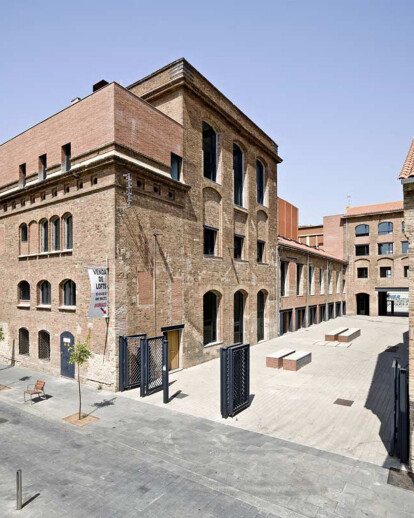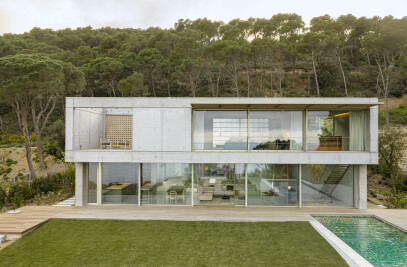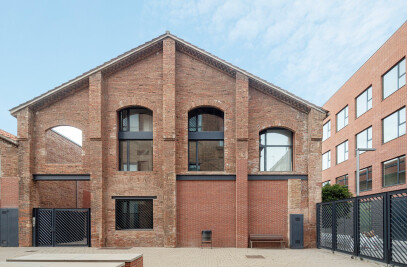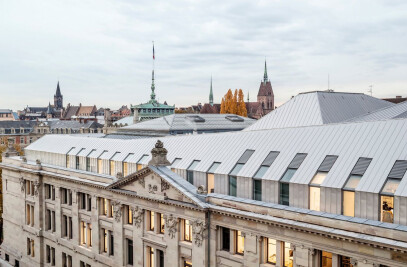The renewal of the industrial area of Poble Nou (District 22 @ Bcn activities) provides its transformation into the new "District 22 @ BCN activities, devoted mainly to the industries of the new economy, information technology and communication. In an old sugar factory a set of unusual characteristics has been presented is transformed into a new use project aimed at a special public that is both dynamic and progressive. There has been the unique result and quality. The project builds on the qualities of the original industrial building. The old warehouses were sectioned vertically with the rhythm set by the existing trusses of the roof structure in order to obtain lofts of two or three levels. The volumes of various built levels have been applied to an adaptive reuse as large open spaces.
The completed portion to date is the northern sector (reaching Carrer Ramon Turró) and two underground parking levels on the south side (near Carrer Doctor Trueta).
The old factory of the early twentieth century occupied a large space inside a city block, an Eixample Cerdà-type city block, located in Pueblo Nuevo, half industrial district, near the residential half of the Ciudadela Park, the Cemetery of the East and the Barcelona coastline. And currently in close proxmity to the Olympic Village and Olympic Port of the Barcelona Games of 1992 -. The non-functioning factory complex is crossed by a passage that splits the city block in two, as occasionally happens in the city blocks of Barcelona and hence comes into contact with the streets, both top and bottom, parallel to the seafront.
On the south side of the passage was only warehouse space of no historical interest that were demolished allowing the construction of two underground car parkings for the overall promotion with a 100- car capacity. The urban and architectural plan integrated on a single idea draws on the use of the old factory that stood at the north side of the lot and the second phase of construction of new buildings above the underground parking garage on the south side of the lot.
The main open space unites, with its consistent position, the two sectors which are separated by the passage, acting as a centerpiece. On the upper side the project changed several industrial buildings and transforms them into a series of unconventional homes or lofts of various types and sizes.
The existing buildings were large warehouse spaces of considerable height in addition to two other taller structures with a capacity of three or four levels, including the porch accessible from the street above. The buildings are built of brick and spanned with truss structures both wooden or metal and ceramic roof tiles on the exterior. In the taller structures, the floor is flat or domed with vertical metal structural elements supporting ceramic domed slabs.
In the project we paid special attention to take advantage of the existing features, ensuring that they are not lost and that they mark the uniqueness or define the character of the apartments. This intention to join the existing structures by adding new uses and interpretations, is what justifies the renovation of old buildings that otherwise would have no reason for conservation. The non-conventional dwellings, 29 in total in this first phase, continued to take shape influenced by the remarkable qualities of the pre-existing factory.
For example, the empty vessels are divided or cut into slices using as origin of the separation between the truss partitions (about 4.30 m) and also by placing the dividing wall on one side of the triangular structural element. In this way the residential units are reminiscent of the warehouse spaces with access on the ground level and enjoying an entire segment of the warehouse from the ground to the roof – each with the presence of a truss in each of the units.
Depending upon the height of each warehouse, we obtained the apartments of two or three levels. There is always a double-height open space in each unit to enjoy the memory of the empty space of the original warehouse. The construction system is simple using dividing bearing walls between apartments acting to support the building load through a simple plan of construction. A kitchen and one or two bathrooms complete the minimum needs of each unit.
In the volumes of various heights we placed a staircase and lift core to access the different lofts. In this case we exploit the virtues of the flat and clear spaces with their different original heights. The surfaces are varied ranging from 100m2 to 220 m2 fleeing from the speculative error that caused the ruin of many industrial buildings that have been ruthlessly chopped and fractioned. The result is an alternative or innovative product that springs forth from the spatial and architectural potential of the original building. The project and site have sought the complicity with the old, while respecting its character and simultaneously proposing its renovation.
In terms of construction, we worked with similar yet not identical bricks and avoided attempts at hiding the appearance of our new collage or patchwork. The openings have been made without complex facades acting, hopefully you feel the result, lightness and a certain complacency. Hence retained, modified or constructed new in turn. There appear metal lintels, carpentry, fences and exterior walls as a complement to the set of construction materials. The interior floors are wood and the exterior are artificial stone pavers.
The intention was to create a whole and its individual elements, the housing-units, all with a certain identity that comes from a place of remembrance while especially proposing new spaces to live with unique urban and domestic qualities.


































